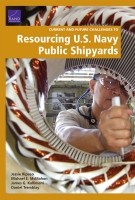| 来源类型 | Research Reports
|
| 规范类型 | 报告
|
| DOI | https://doi.org/10.7249/RR1552
|
| ISBN | 9780833097620
|
| 来源ID | RR-1552-NAVY
|
| Current and Future Challenges to Resourcing U.S. Navy Public Shipyards |
| Jessie Riposo; Michael McMahon; James G. Kallimani; Daniel Tremblay
|
| 发表日期 | 2017
|
| 出版年 | 2017
|
| 页码 | 98
|
| 语种 | 英语
|
| 结论 |
Workload Is Increasing and Becoming More Complex- The shipyards are maintaining three more nuclear-powered aircraft carriers than in FY 2000. This alone results in an average annual increase of a little more than 150,000 total man-days per ship, or 450,000 annual man-days.
- Increases in the duration of the operational cycle have caused more work in fewer maintenance periods, or availabilities. This leads to larger, less-frequent availabilities, which are more difficult for the shipyards to manage, often leading to inefficiency in execution.
A Less-Experienced Workforce Is Less Productive- Workforce experience has decreased. For example, the percentage of the total civilian workforce with less than ten years of experience has increased from 35 percent in FY 2006 to nearly 50 percent in FY 2014, while the percentage with 20–29 years of experience decreased from 31 percent to 12 percent.
- As the total shipyard workforce increases and experienced workers are replaced with less-experienced ones, we observe a decline in overall workforce productivity.
Aging Ships, Longer Deployment Cycles, and the Budgeting Process Likely Lead to Increases in Workload- Nuclear submarines in the current fleet will continue to age in the near and middle terms, which could have significant consequences both for the Navy operationally and for maintenance execution in the naval shipyards.
- Based on discussions with staff from the Carrier Planning Activity and naval shipyards, the additional maintenance generated by the higher operational trends is recoverable but may require longer aircraft carrier dry-docking periods, additional maintenance man-days, and some unplanned component replacements.
- The budgeting process requires the Navy to estimate maintenance requirements two years prior to execution, when much of the maintenance activity is still unknown. Furthermore, the efforts to estimate risk and plan for the unexpected may be thwarted by overly optimistic performance factors. All of this points to a risk of additional, unplanned work for the public shipyards in the execution year.
|
| 摘要 |
- The Navy should consider hiring additional resources. The productivity model, historical trends, and risk factors predict a need above currently planned levels.
- The Navy should continue investment in accelerated training programs across all critical trades and find new hires that have experience. Accelerated training creates productive workers more quickly and minimizes the potential increases to the size of the workforce. Hiring individuals with even one year of experience can have a significant effect on overall workforce productivity.
- The Navy should consider mitigating workload by outsourcing some of the work. A fully productive workforce cannot be established in time to execute the near-term peaks.
|
| 主题 | Civilian Military Workforce
; Maintenance
; Repair
; and Overhaul
; Military Ships and Naval Vessels
; United States Navy
; Workforce Management
|
| URL | https://www.rand.org/pubs/research_reports/RR1552.html
|
| 来源智库 | RAND Corporation (United States)
|
| 引用统计 |
|
| 资源类型 | 智库出版物
|
| 条目标识符 | http://119.78.100.153/handle/2XGU8XDN/108506
|
推荐引用方式
GB/T 7714 |
Jessie Riposo,Michael McMahon,James G. Kallimani,et al. Current and Future Challenges to Resourcing U.S. Navy Public Shipyards. 2017.
|
|
文件名:
|
x1495316789179.jpg
|
|
格式:
|
JPEG
|

|
文件名:
|
RAND_RR1552.pdf
|
|
格式:
|
Adobe PDF
|
除非特别说明,本系统中所有内容都受版权保护,并保留所有权利。